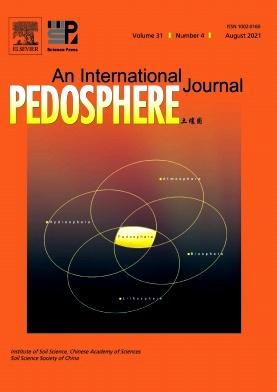Arsenic mobilization and nitrous oxide emission modulation by different nitrogen management strategies in a flooded ammonia-enriched paddy soil
IF 5.2
2区 农林科学
Q1 SOIL SCIENCE
引用次数: 0
Abstract
Elevated arsenic (As) mobilization and increased nitrous oxide (N2O) emission are two primary environmental concerns existing in flooded paddy soils. In this study, dissolved As(III), N isotope-labeled Na15NO3, and/or 14NH4Cl were incorporated into a microcosm incubation to determine the effects of N fertilization regimes on As mobilization and N2O emission in a flooded paddy soil. Because nitrate had a higher redox potential and comprised a higher proportion of N substrate, As(V) was preferentially formed due to enhanced nitrate-dependent microbial As(III) oxidation. Thus, As availability was correspondingly attenuated due to the improved production of less mobile and toxic As(V). After 2-d incubation, more than 90% and 98% of soluble As(III) were immobilized in the As + NH4+-N + NO3--N and As + NO3--N treatments, respectively. Following nitrate depletion (after 2 d), microbial As(V) and Fe(III) reductions were gradually enhanced, which was attributed to stimulation of anaerobic ammonium oxidation (anammox) coupled to Fe(III) reduction, known as Feammox, by the abundance of NH4+. By the end of the incubation period (10 d), the As + NO3--N treatment led to higher As immobilization of originally added As(III) (ca. 61%) than the As + NH4+-N + NO3--N treatment (42%). The As + NH4+-N + NO3--N treatment prominently mitigated N2O emission compared to the As + NO3--N treatment, which was ascribed to anammox, inducing accumulation of byproducts from incomplete denitrification. High-throughput sequencing indicated that the relative abundances of denitrifiers (e.g., Azoarcus, Ochrobactrum, and Thiobacillus denitrificans) increased in the As + NO3- treatment, whereas quantitative polymerase chain reaction results indicated higher 16S rRNA gene copy numbers for anammox and Feammox (Acidimicrobiaceae bacterium A6) bacteria in the As + NH4+ + NO3- treatment. Collectively, the experimental results demonstrated that N fertilization can be a feasible As remediation strategy while providing an effective strategy for mitigating N2O emission from paddy soils at the same time.
淹水富氨水稻土不同氮素管理策略对砷迁移和氧化亚氮排放的调节
砷(As)动员升高和氧化亚氮(N2O)排放增加是水淹稻田土壤中存在的两个主要环境问题。在本研究中,将溶解的As(III)、N同位素标记的Na15NO3和/或14NH4Cl加入微观培养皿中,以确定施氮方式对淹水水稻土As动员和N2O排放的影响。由于硝酸盐具有较高的氧化还原电位,并且含有较高比例的N基质,由于硝酸盐依赖的微生物As(III)氧化增强,As(V)优先形成。因此,由于较不灵活和毒性较弱的As(V)的生产得到改善,As的可用性相应减弱。培养2 d后,As + NH4+-N + NO3——N和As + NO3——N处理下,可溶性As(III)的固定化率分别超过90%和98%。在硝酸盐耗尽后(2天后),微生物As(V)和Fe(III)的还原逐渐增强,这是由于NH4+丰度刺激厌氧氨氧化(anammox)和Fe(III)还原(称为Feammox)。在孵育期(10 d)结束时,As + NO3——N处理导致原添加As(III)的As固定化(约61%)高于As + NH4+-N + NO3——N处理(42%)。与As + NO3—N处理相比,As + NH4+-N + NO3—N处理显著减少了N2O排放,这归因于厌氧氨氧化,诱导了不完全反硝化副产物的积累。高通量测序结果显示,As + NO3-处理下反硝化菌(Azoarcus、Ochrobactrum和Thiobacillus反硝化)的相对丰度增加,而定量聚合酶链反应结果显示,As + NH4+ + NO3-处理下厌氧氨氧化菌和酸化菌科细菌A6的16S rRNA基因拷贝数增加。综上所述,试验结果表明,施氮是一种可行的水稻土氮氧化物修复策略,同时也为减少水稻土N2O排放提供了有效的策略。
本文章由计算机程序翻译,如有差异,请以英文原文为准。
求助全文
约1分钟内获得全文
求助全文
来源期刊

Pedosphere
环境科学-土壤科学
CiteScore
11.70
自引率
1.80%
发文量
147
审稿时长
5.0 months
期刊介绍:
PEDOSPHERE—a peer-reviewed international journal published bimonthly in English—welcomes submissions from scientists around the world under a broad scope of topics relevant to timely, high quality original research findings, especially up-to-date achievements and advances in the entire field of soil science studies dealing with environmental science, ecology, agriculture, bioscience, geoscience, forestry, etc. It publishes mainly original research articles as well as some reviews, mini reviews, short communications and special issues.
文献相关原料
公司名称
产品信息
阿拉丁
Na15NO3
 求助内容:
求助内容: 应助结果提醒方式:
应助结果提醒方式:


